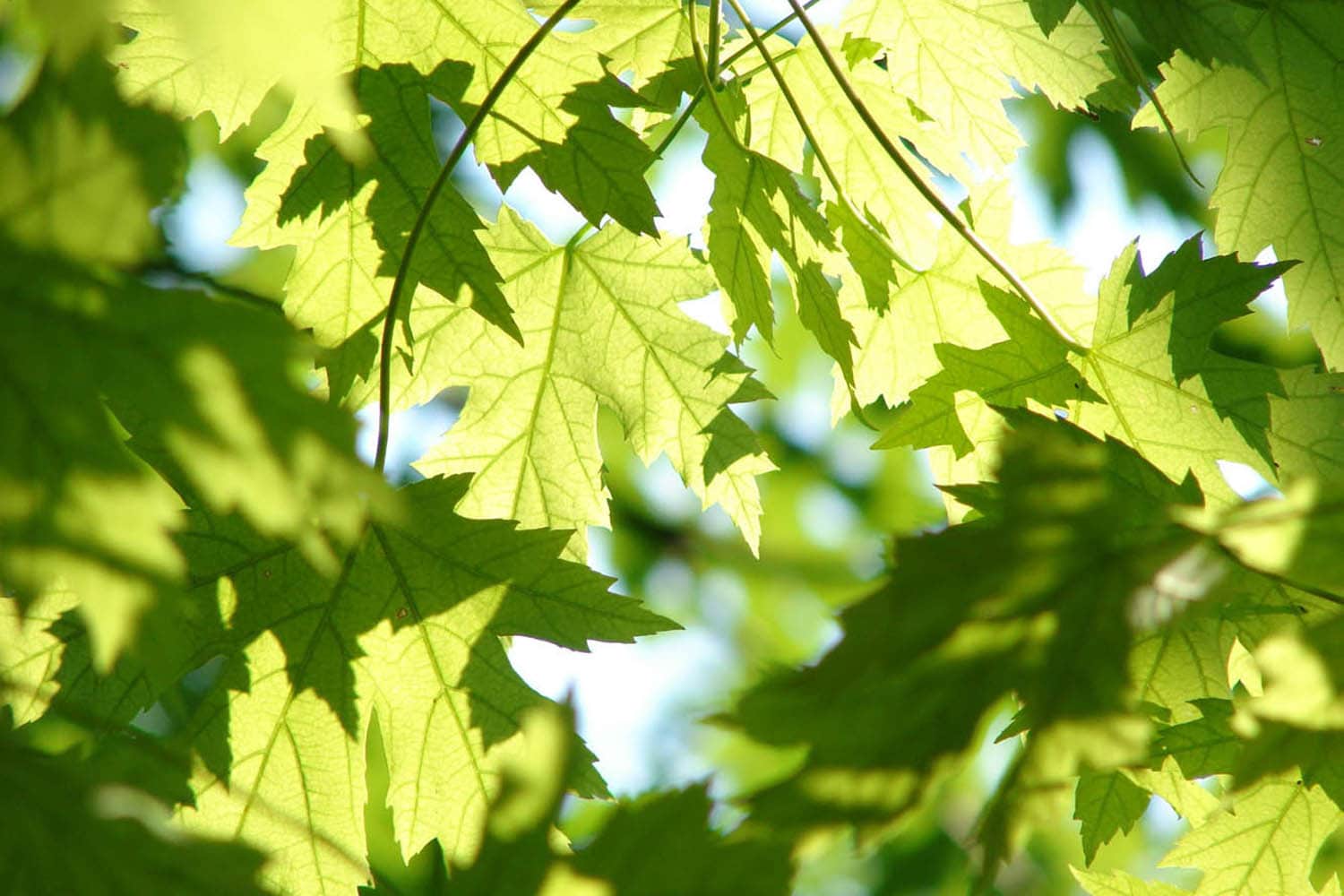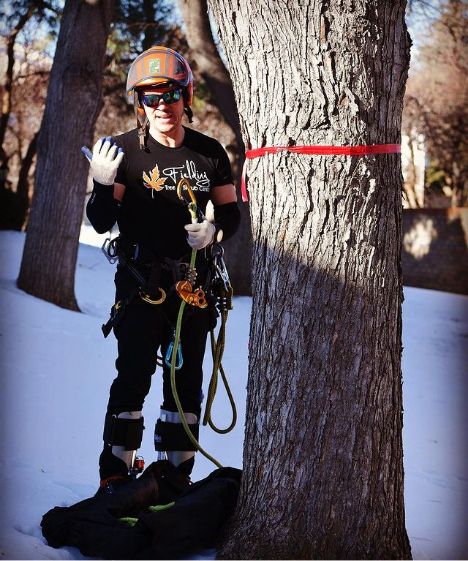Silver Maple trees in the Denver metro area have suffered from less-than-ideal environmental conditions and frost damage in recent years. This has caused many maples to die, creating hazards for people and property. In this article, we will discuss how Denver homeowners can identify environmental stressors affecting these trees, how to mitigate further frost damage, and how to treat maple tree diseases—insights that highlight the importance of expert tree care in Denver.
General Information on Silver Maple Trees
The Silver Maple is a tree that can grow up to 100 feet tall, making it one of the tallest trees in our Centennial state. It is a deciduous tree, meaning that it loses its leaves in the fall. They are known for their reddish flowers that bloom prior to leaf-out in the springtime.
They are native to the eastern United States but are now a staple in the Colorado urban environments as well. It prefers moist soils and grows best in full sun. It is a relatively fast-growing tree, which has made it a popular choice for homeowners and landscapers alike.
You can do a quick check around your property and identify any Silver Maples by looking for their unique leaves. The leaves are large, with five lobes, and they have a silver sheen on the underside. The leaves turn yellow in the fall before they drop off.
Other physical characteristics of Silver Maples include:
- Smooth, gray bark, that peels in long strips as the tree approaches maturity
- Branches or twigs that are opposite one another on branches
- A rounded crown
Silver Maple Trees in Denver Are Under Stress
What does it mean for a tree to be stressed, exactly? Well, it’s similar to when a human is stressed. Environmental factors lower the immune system and make it more difficult to thrive and function properly. When a tree is stressed, it means that it is not able to produce the necessary amount of chlorophyll. Chlorophyll is what gives leaves their green color and helps the tree turn sunlight into energy. A stressed tree is less likely to be able to defend itself from pests and maple tree diseases. It is also more likely to be damaged by severe weather conditions, like high winds, heavy snow, or even frost.
Signs That Your Silver Maple Is Damaged
Silver Maple Trees that have sustained frost damage may display any of the following signs:
- leaf buds that haven’t swollen or begun opening by April
- shriveling and browning or blackening of damaged tissue
- shriveled and discolored leaves
- dead or dying branches
In some cases, the entire tree may be dead. If you see any of these signs, it’s important to take action right away. The tricky thing is, that it can take months for the first signs of frost damage and stress to become evident. To be safe, have a certified arborist check the overall health of your Silver Maple trees ASAP.
Frost Damage
Recently, the Silver Maple has been under stress due to environmental conditions. The last few years have brought extreme heat and drought to Colorado, followed by harsh winters with below-average temperatures and little snowfall. These conditions have put the Silver Maple at considerable risk.
Frost damage is a common problem in Colorado, especially for Silver Maples. In the last few years, we’ve seen an increase in the amount of damage caused by frost. Frost damage manifests itself as dead branches (especially the tips), or overall dieback of the tree. In some cases, the entire tree may be killed.
What Causes Frost Damage?
Frost damage is caused by the exposure of the tree to rapidly dropping freezing temperatures. When the temperature drops below freezing, the water in the cells of the tree’s leaves and branches might freeze. This can cause the cells to burst!
Preventative Care Against Frost Damage
Prevention is always the best medicine. If you know that your Silver Maple Tree is susceptible to frost damage, take steps to protect it before the cold weather sets in.
- Watering your tree deeply and regularly during the summer months will help it withstand the stress of winter.
- You can also wrap your trees under 8” diameter around trunks in a breathable material like burlap in the winter to help insulate it from the cold. “Winter Trunk Wrap” is readily available at most garden centers or online.
If you notice frost damage on your Silver Maple, don’t panic! There are steps you can take to help your tree recover.
First, remove any dead or damaged limbs from the tree. This will help prevent the spread of disease and decay. Trimming dead branches also allows for proper wound closure as well as opening up space for new, healthy growth.
Don’t forget to fertilize your tree! This will help it recover from the stress of frost damage and encourage new growth. Tree fertilization is truly a science, and there are many products available on the market. Be sure to do your research and find the best product for your tree’s needs.
Our expert arborists are happy to lend a hand! They’ll determine which key nutrients are missing from your soil and craft a custom fertilization plan to perfectly fit your needs.
Finally, give your tree time to recover. Just like us, trees need time to heal and regrow. The good news is that with proper care, your Silver Maple Tree will be back to its old self in no time!
If you have any questions or would like to schedule a consultation, please don’t hesitate to reach out. We’re always here to help!
Be Aware of Safety Hazards When Trimming
Silver Maple Trees with frost damage can pose a serious safety hazard. Denver area officials are working diligently to clear away dead and dying trees that have fallen or are in danger of toppling over.
If you have a Silver Maple Tree on your property, it’s important to be aware of the potential dangers it poses. It is your responsibility to complete the proper trimming and maintenance to prevent any future accidents from occurring.
Trees with dead limbs are especially dangerous because they can fall without warning. If you have one with any dead or dying limbs, it’s important to have them removed as soon as possible.
The cost of removal for a Silver Maple Tree can be expensive, especially if the tree is large. Most homeowners are unable to remove the tree themselves and will need to hire a professional arborist to do the job for them. Trees that are highly damaged are unsafe for arborists to climb as well, which is why tree care professionals prefer to catch the damage in its early stages and remove affected areas safely.
Maple Tree Diseases
At Fielding Tree Care, we are optimistic about helping Denver’s Silver Maple Trees recover from their recent frost damage. Our team has years of experience and expertise to apply to this problem. However, the stakes are high because trees that go untreated are at great risk for developing chlorosis.
What is Chlorosis?
Chlorosis is a disorder that most often is a result of nutrient deficiency, typically iron or manganese. This can also be caused by other factors like having excessive moisture or a pH imbalance. Chlorosis manifests as yellowing leaves, with the veins remaining green. This is due to the fact that chlorophyll, the molecule responsible for photosynthesis, requires iron to function.
Trees that are susceptible to chlorosis can sustain many types of damage such as:
- Fruit and flower production may be reduced
- The growth of your tree may be stunted
- The overall vigor and health of the tree can decline
- In some cases, chlorosis can lead to the death of the tree
According to Colorado State University Extension, Silver Maples are especially susceptible to this disorder. There are several environmental factors that can make Chlorosis more severe:
- Insufficient soil oxygen or anything that affects root function in the soil can worsen iron chlorosis or cause it to appear in less chlorosis-prone trees.
- Compacted clay soils and overwatering can both result in lowered levels of soil oxygen.
- Sometimes, where planting density is high or there are other plants competing for water and minerals, trees may develop iron chlorosis.
- When your plants are over-fertilized with phosphorus, iron chlorosis may develop as the roots take up phosphorus to the exclusion of iron.
High pH soils can also make it difficult for trees to take up iron. Environmental conditions such as these often cause or worsen other problems that may lead to the death of the tree. Consequently, the first step in dealing with chlorosis is to improve cultural care.
These are the top treatment approaches we recommend to you from the experts at CSU:
- add iron sulfate to your soil – effectiveness may be limited
- add iron chelates to soil – some are more effective than others depending on soil alkalinity
- addition of sulfur to lower soil pH – less feasible when alkaline soils are high in lime
- iron sprays to foliage – often impractical, especially on large trees, the effect is only temporary
- trunk injections – holes drilled in the trunk may provide entry for disease organisms; best left to certified arborists, but this is the most effective method for treating chlorosis
Contact Fielding Tree Care
It’s been a tough year for Silver Maple Trees in Colorado, and many are struggling to recover from the frost damage they sustained. We can carefully assess and work with you to create a treatment plan to recover from maple tree diseases and get them back to full health!
The first step to getting your Silver Maple trees the help they need is identification, so schedule a consultation with one of our friendly arborists today!






